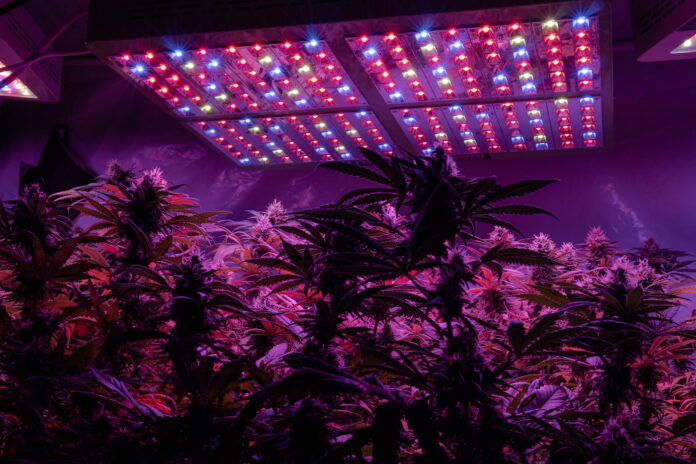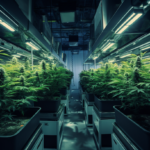Selecting the right lighting for cannabis cultivation is a critical decision that can significantly influence the quality, yield, and profitability of an indoor grow operation. Whether managing a large-scale commercial facility or a small home setup, the type of grow lights selected will directly impact not only the plants’ growth but also the sustainability and cost-effectiveness of the entire operation. As the cannabis industry matures, energy efficiency and eco-friendliness have become more serious considerations alongside traditional factors like flower quality and yield.
In this article, we’ll explore the role of light-emitting diode (LED) grow lights in cannabis cultivation. We’ll weigh the pros and cons of LED technology, compare it with other lighting options, and examine how LEDs can enhance efficiency, sustainability, and ultimately, the profitability of a commercial cannabis grow.
Cannabis Grow Lights
Different light technologies can emit different types of light. While older marijuana grow lights might have prioritized flower quality and yield, today’s weed lights are much more likely to factor in energy efficiency and sustainability, especially as the greater industry continues to prioritize these aspects of eco- and cost-friendliness.
UV lighting for plants has proven to be great for trichome production and large product yields, and many indoor facilities utilize a mix of UV and LED lights for optimal results. However, there are a few other reasons more cultivators are turning to LED lighting, largely based on the disadvantages of other lighting mediums utilized throughout cannabis’s growing history.
High-intensity discharge (HID)
HID lights come in two versions: metal halide (MH) or high-pressure sodium (HPS). MH lights produce a cooler blue light, while HPS lights emit a red color. Because of the difference here, MH lights are typically utilized during the vegetative stage of growing cannabis, while HPS lights are best suited for the flowering stage.
HID lamps tend to have a lower initial cost than higher-end LED grow lights, and they’re typically quite easy to set up, which is great for a beginner or experienced cultivator getting a new facility up and running quickly. However, this type of lightbulb degrades over time while emitting incandescent light with intense heat.
Incandescent light bulbs run the risk of burning plants. When heat is a factor in the grow room, it’s important to pay careful attention to the distance between each plant and the incandescent bulbs, regularly making adjustments to keep growing plants at the optimal distance for temperature and humidity.
Fluorescent light bulbs
Fluorescent lights are most often utilized in smaller grow rooms, as they‘re typically more affordable. Full-spectrum starter lights are also attractive because they don’t require any special equipment to install, making implementation a relatively fast and easy process.
This type of UV light is widely available for purchase, comes in various levels of wattage and color temperatures, and does not consume an abundant amount of energy. However, they have limitations with low UV lighting output and are therefore only suitable for growing about one or two plants at a time.
Fluorescent lights are not optimal for the flowering stage as they produce quite subpar yields, and they tend to have a shorter lifespan than other types of lights which may render them more costly when used over multiple harvests in a large commercial setting.
Disadvantages of LED lights
There are a few disadvantages to implementing LED lights in a cannabis grow room, and these are important aspects to consider for anyone thinking about switching to LED light bulbs. Here are some of the major cons of LED lights for indoor cannabis cultivation.
1. Steep upfront expense
One of the most well-known disadvantages of LEDs is the price tag. Opting for the highest-quality type of LED light is a long-term investment to pay off over the next 12 to 15 years. For many small operations or new ventures, the initial cost of adoption may be out of reach.
2. Sensitivity to high temperature
LED grow lights can be very sensitive to high temperatures, which can ultimately affect the quality of light they provide to growing plants. To avoid this, operators must invest in a high-quality output fan system to keep the lights at a cool and stable temperature. This need for cooling adds to the already relatively high initial cost of implementing a light system that incorporates LEDs.
3. Lackluster results with cheap LEDs
For those looking to purchase less expensive LED lights, there are certainly options on the market. Unfortunately, many of the lower-priced options fail to produce the best results. Cutting back on costs at this stage can leave plants vulnerable to temperature fluctuations that can result in leaf burns, which can lead to any number of plant health issues including nutrient deficiencies and lower immunity to fight pathogens.
4. Risk of lower yields
When compared to other grow light options like HID lights, LEDs might produce lower yields per harvest. For large cultivation facilities looking to produce the highest quantity of high-quality products, any potential negative impact on yield is likely a non-starter.
Advantages of LED lights
For all of the disadvantages LED lights might come with, there’s an undeniably wide variety of benefits. From sustainability to healthier plants, here are some of the major reasons cultivators opt for LED bulbs in their grow rooms.
1. Additional harvests
LED lights can be used for up to 24 hours per day, which ultimately allows growers to shorten the season and increase the plants’ growth rate. These lights help growers achieve multiple harvests per season, resulting in a potentially higher yield over an extended period.
2. Long lifespan
LED grow lights can thrive for up to 50,000 hours, thanks to their relatively low operating temperature range. Although they can be costly upfront, anyone who’s most concerned with long-term profitability will likely see a net gain with lower equipment expenses using lights that can last up to 15 years working in normal growing cycles.
3. Energy efficiency
In general, LED lights will consume about 60 percent less energy than other traditional lighting options, while still providing the same amount of light. They also emit less heat overall and provide more usable light than other systems used to grow marijuana plants. If recurrent energy costs are a cause for concern, the long-term benefits of LEDs may make up for their higher initial price tag.
4. Full spectrum of light
High-quality LED lights will provide a full spectrum of light, meaning they’ll give cannabis plants all of the light they need to thrive. Most LED lights will also allow cultivators to adjust the wavelengths depending on the growth cycle stage. For many experienced commercial cultivators, dialing in the perfect light for each cultivar is the difference between a very good flower and one that dazzles judges and demands customer loyalty.
6 LED lights to consider
Spider Farmer SF 1000
The SF1000 is an affordable option for small or entry-level grows. The 100W light comes from Samsung EVO LMB301B LEDs that emit 9600Lm ± 5 percent of light, capable of coverage for up to four cannabis plants.
Mars Hydro FC-E1000W
The FC-E1000W is a mid-range, full-spectrum LED bar with impressive efficiency providing up to 2.8 µmol/j. With ten LED bars, the lighting platform offers optimal coverage for up to six cannabis plants.
Gavita RS 1900e
The RS 1900e is a top-tier, full-spectrum LED solution that’s dimmable to 10 percent. It features a broad white light with an enhanced blue spectrum designed to intensify terpene and cannabinoid production with an impressively efficient 3.0 μmol/j.
Lumatek Zeus 600W PRO 3.1
The Zeus 600W Pro 3.1 is a powerful linear multi-light aluminum bar fixture capable of producing 1990 µmol/s with a photon efficiency of 3.1 µmol/j. This LED option for commercial operators seeking higher yields covers about 25 square feet for vegetative and flowering stages
AC Infinity IONFRAME EVO10
The IONFRAME EVO10 is a professional-grade LED bar for commercial operators. It features Samsung LM301H EVO LEDs, each rated at 3.14 µmol/j, providing 25 square feet of general-purpose coverage, 36 square feet of flower coverage, and 49 square feet of veg coverage. The commercial system supports daisy-chaining with up to 80 grow lights.
Fluence VYPR 4
The VYPR 4 is another professional-grade LED option for commercial operators. It features a low-profile design for minimal shading in the greenhouse, a dual-channel far-red spectrum for light recipes, and an efficiency of 2.7 to 3.6 μmol/j. The VYPR 4 is available in a multitude of PhysioSpec spectra for optimal efficiency, consistency, and yield across a variety of cultivars.











[…] Village in Manhattan and Noxx Cannabis in Grand Rapids, Michigan, and East Peoria, Illinois, colored lights beneath display counters draw customers in. But Noxx goes further, placing floor-to-ceiling […]
[…] and ultraviolet-visible (UV) spectrums capable of stimulating plant growth. Light-emitting diode (LED) lights can integrate with programmable controllers to achieve different intensities and wavelengths, optimizing output […]
[…] the as-yet-unnamed proof-of-concept device enhances the experience of bud-sniffing by integrating a light source and fan into the base of the unit. When a consumer lifts the bell-shaped wand from the base, the […]
[…] environment. Companies have created sensors for monitoring temperature, humidity, CO2 levels, and light conditions. Environmental sensors are available as handheld devices, but many work in conjunction with […]
[…] cultivators use one of three types of lights: LEDs, high-pressure sodium (HPS), or metal halide (MH). While other bulbs may work, these provide the […]
[…] https://mgmagazine.com/business/growing-horticulture/led-lighting-pros-and-cons/ […]
[…] is a dynamic plant, requiring many unique inputs to thrive. From cannabis nutrients to soil pH and the right light, it takes a laundry list of ingredients to get potent buds and high yields. One of the most […]
[…] https://mgmagazine.com/business/growing-horticulture/led-lighting-pros-and-cons/ […]
[…] fan leaves are allowed to grow too much, they may hinder your success, blocking valuable light penetration and airflow from the bottom of the plants when they need it most, which is especially important if […]
[…] watered, and cared for. This means they’re constantly having to think about proper temperature, lighting, and humidity levels—and little […]
[…] today, there are HPS holdouts—mostly on the West Coast—who aren’t completely convinced of LEDs’ performance, environmental, and long-term cost benefits, but the data doesn’t lie. LED lights have proved to produce more light than HPS on a per-watt […]
[…] industry is much more complex and expensive than it was ten, or even five, years ago. With major advances in lighting, fertigation, HVAC, data collection, and virtually every other aspect of the process, today’s […]
[…] with other forms of cannabis grow lights, there are some LED lighting pros and cons to weigh before making a decision. Here are some of the main things to […]
[…] also is impacting the industry well beyond New Frontier Data’s deployments. From lighting, watering, and feeding systems in [cultivation operations] to sophisticated inventory prediction […]
[…] your plants aren’t getting their basic needs met with temperature, humidity levels, grow medium, proper lighting light, water, pH and diet, they’re going to develop nutrient deficiencies that can be detrimental to a […]
[…] main advantage of autoflowers is predictability,” said Lind. “Since autoflowers don’t rely on light cycles to control flowering, you can plant your seeds and reliably harvest 70-100 days later, creating a constant throughput […]
[…] the quality of flower, the discussion is dominated by everything that happens before the harvest. Lighting, soil types, nutrients, pH, and a myriad of other inputs play a critical role in the development of […]